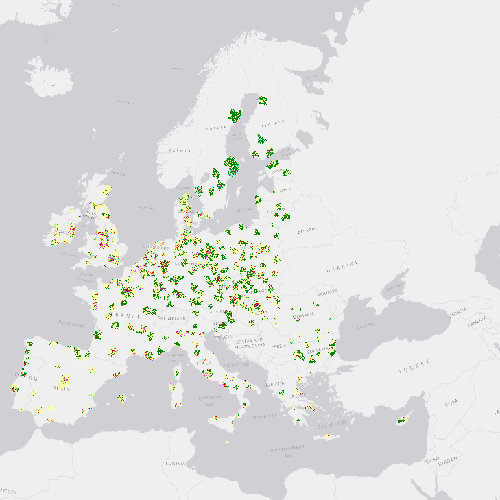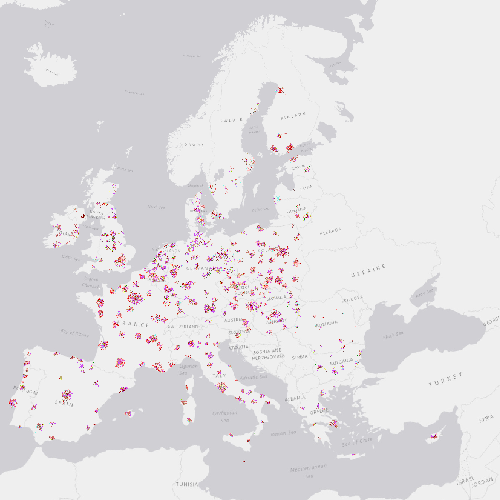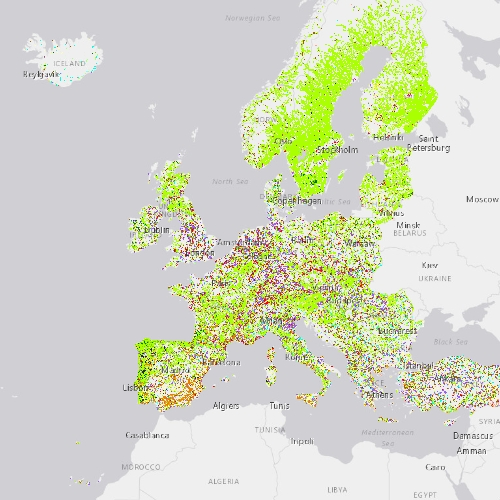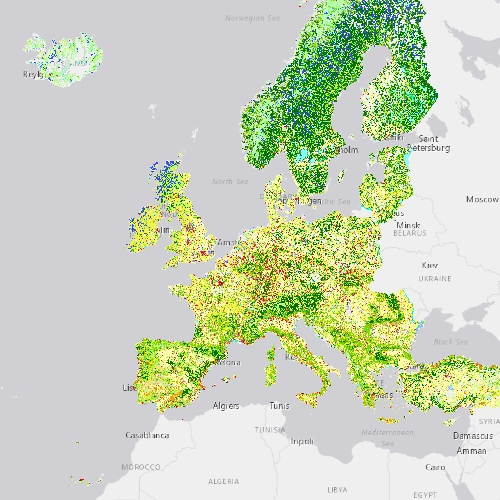SHP
Type of resources
Available actions
Topics
Keywords
Contact for the resource
Provided by
Years
Formats
Representation types
Update frequencies
status
Scale
Resolution
-

The European Urban Atlas provides reliable, inter-comparable, high-resolution land use maps for 305 Large Urban Zones and their surroundings (more than 100.000 inhabitants as defined by the Urban Audit) for the reference year 2006 in EU member states. Urban Atlas is a joint initiative of the European Commission Directorate-General for Regional and Urban Policy and the Directorate-General for Enterprise and Industry in the frame of the EU Copernicus programme, with the support of the European Space Agency and the European Environment Agency.
-

This collection is a legacy product that is no longer supported. It may not meet current Government standards. The National Topographic Data Base (NTDB) comprises digital vector data sets that cover the entire Canadian landmass. The NTDB includes features such as watercourses, urban areas, railways, roads, vegetation, and relief. The organizational unit for the NTDB is the National Topographic System (NTS), based on the North American Datum of 1983 (NAD83). Each file (data set) consists of one NTS unit at either the 1:50,000 or 1:250,000 scale. Related Products: [NTDB Correction Matrices, 2003-2009](https://ouvert.canada.ca/data/en/dataset/b6d0c19c-27e3-4392-b21f-49b1eec95653)
-

Gögin upplýsingar um strok og tjón sem hefur átt sér stað sjókvíeldi. Hægt er að sjá hvar strokið átti sér stað, hvenær og hverskonar fiskur strauk. Einnig er hægt að sjá hvort hjón var á búnaði eða gat á kví. Fyrir frekari upplýsingar er bent á að hafa samband við matvælastofnun.
-

Í gögnunum er að finna upplýsingar um staðsetningu og umfang verndarsvæða í byggð sem ráðherra hefur staðfest í samræmi við lög nr. 87/2015 um verndarsvæði í byggð. Markmið laganna er að stuðla að varpveislu og vernd byggðar sem hefur sögulegt gildi.
-

The Urban Atlas provides pan-European comparable land use and land cover data for Functional Urban Areas (FUA). The Urban Atlas Change layers have become available from 2012 and only for all FUAs that have been covered in both 2006 and 2012 reference years. Urban Atlas is a joint initiative of the European Commission Directorate-General for Regional and Urban Policy and the Directorate-General for Enterprise and Industry in the frame of the EU Copernicus programme, with the support of the European Space Agency and the European Environment Agency.
-

Herring Section shapefile - used for spatial analysis/presentation of data from Herring Stock Assessment Database.
-

Línurnar sýna friðunarsvæði, þar sem eldi laxfiska (fam. salmonidae) í sjókvíum er óheimilt skv. auglýsingu nr. 460/2004.
-

The Urban Atlas provides pan-European comparable land use and land cover data for Functional Urban Areas (FUA). The Street Tree Layer (STL) is a separate layer from the Urban Atlas 2012 LU/LC layer produced within the level 1 urban mask for each FUA. It includes contiguous rows or a patches of trees covering 500 m² or more and with a minimum width of 10 meter over "Artificial surfaces" (nomenclature class 1) inside FUA (i.e. rows of trees along the road network outside urban areas or forest adjacent to urban areas should not be included). Urban Atlas is a joint initiative of the European Commission Directorate-General for Regional and Urban Policy and the Directorate-General for Enterprise and Industry in the frame of the EU Copernicus programme, with the support of the European Space Agency and the European Environment Agency.
-

Riparian zones represent transitional areas occurring between land and freshwater ecosystems, characterised by distinctive hydrology, soil and biotic conditions and strongly influenced by the stream water. They provide a wide range of riparian functions (e.g. chemical filtration, flood control, bank stabilization, aquatic life and riparian wildlife support, etc.) and ecosystem services. The Riparian Zones products support the objectives of several European legal acts and policy initiatives, such as the EU Biodiversity Strategy to 2020, the Habitats and Birds Directives and the Water Framework Directive. This metadata refers to the Riparian Zones Land Cover/Land Use (LC/LU) change for 2012-2018. The LC/LU classification is tailored to the needs of biodiversity monitoring in a variable buffer zone of selected rivers (Strahler levels 2-9 derived from EU-Hydro) for the change layer 2012-2018. LC/LU is extracted from Very High Resolution (VHR) satellite data and other available data in a buffer zone of selected rivers for supporting biodiversity monitoring and mapping and assessment of ecosystems and their services. The class definitions follow the pre-defined nomenclature on the basis of Mapping and Assessment of Ecosystems and their Services (MAES) typology of ecosystems (Level 1 to Level 4) and CORINE Land Cover. The classification provides 55 distinct thematic classes with a Minimum Mapping Unit (MMU) of 0.5 ha and a Minimum Mapping Width (MMW) of 10 m. The production of the Riparian Zones products was coordinated by the European Environment Agency in the frame of the EU Copernicus programme.
-

Riparian zones represent transitional areas occurring between land and freshwater ecosystems, characterised by distinctive hydrology, soil and biotic conditions and strongly influenced by the stream water. They provide a wide range of riparian functions (e.g. chemical filtration, flood control, bank stabilization, aquatic life and riparian wildlife support, etc.) and ecosystem services. The Riparian Zones products support the objectives of several European legal acts and policy initiatives, such as the EU Biodiversity Strategy to 2020, the Habitats and Birds Directives and the Water Framework Directive. This metadata refers to the Riparian Zones 2012 Land Cover/Land Use (LC/LU), which LC/LU classification is tailored to the needs of biodiversity monitoring in a variable buffer zone of selected rivers (Strahler levels 2-9 derived from EU-Hydro) for the reference year 2012. LC/LU is extracted from Very High Resolution (VHR) satellite data and other available data in a buffer zone of selected rivers for supporting biodiversity monitoring and mapping and assessment of ecosystems and their services. The class definitions follow the pre-defined nomenclature on the basis of Mapping and Assessment of Ecosystems and their Services (MAES) typology of ecosystems (Level 1 to Level 4) and CORINE Land Cover. The classification provides 55 distinct thematic classes with a Minimum Mapping Unit (MMU) of 0.5 ha and a Minimum Mapping Width (MMW) of 10 m. The nomenclature has been revised in 2020 with the aim to harmonize the products of the local components (mainly Riparian Zones and NATURA 2000 products) while maintaining user requirements for both products. A revised version of the Riparian Zones 2012 has been subsequently released in December 2021, together with the reference year 2018. The production of the Riparian Zones products was coordinated by the European Environment Agency in the frame of the EU Copernicus programme.
 Arctic SDI catalogue
Arctic SDI catalogue